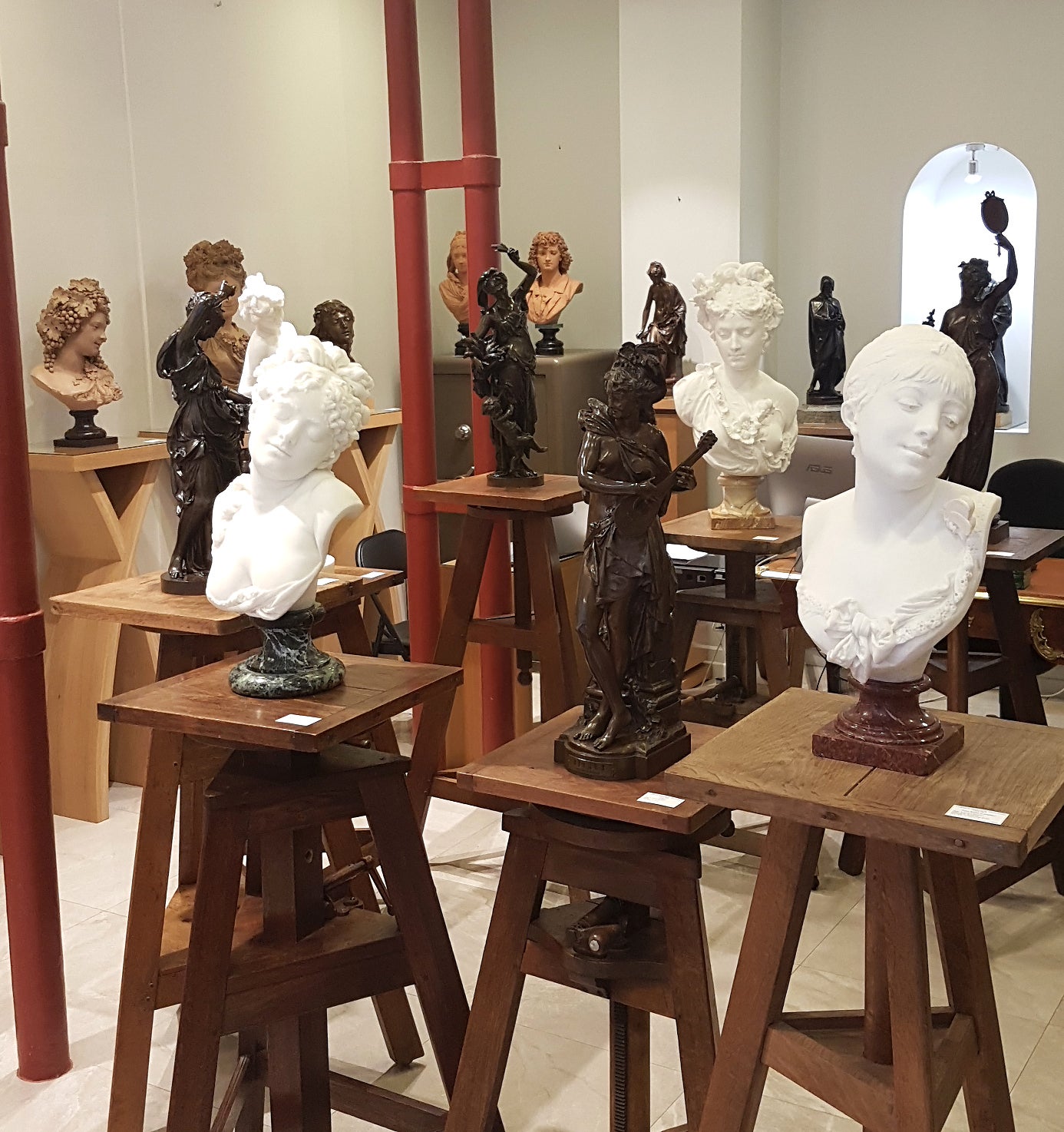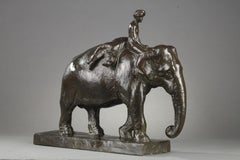Want more images or videos?
Request additional images or videos from the seller
1 of 8
Janet ScudderThe Brideearly 20th century
early 20th century
$7,120.38List Price
About the Item
- Creator:Janet Scudder (1869 - 1940, American)
- Creation Year:early 20th century
- Dimensions:Height: 11.03 in (28 cm)Width: 4.73 in (12 cm)Depth: 2.96 in (7.5 cm)
- Medium:
- Movement & Style:
- Period:
- Condition:
- Gallery Location:PARIS, FR
- Reference Number:Seller: N.52851stDibs: LU2514213977722

About the Seller
5.0
Recognized Seller
These prestigious sellers are industry leaders and represent the highest echelon for item quality and design.
Gold Seller
Premium sellers maintaining a 4.3+ rating and 24-hour response times
Established in 1992
1stDibs seller since 2023
10 sales on 1stDibs
Typical response time: 12 hours
Authenticity Guarantee
In the unlikely event there’s an issue with an item’s authenticity, contact us within 1 year for a full refund. DetailsMoney-Back Guarantee
If your item is not as described, is damaged in transit, or does not arrive, contact us within 7 days for a full refund. Details24-Hour Cancellation
You have a 24-hour grace period in which to reconsider your purchase, with no questions asked.Vetted Professional Sellers
Our world-class sellers must adhere to strict standards for service and quality, maintaining the integrity of our listings.Price-Match Guarantee
If you find that a seller listed the same item for a lower price elsewhere, we’ll match it.Trusted Global Delivery
Our best-in-class carrier network provides specialized shipping options worldwide, including custom delivery.You May Also Like
Bust Of A Young Woman bronze
By Kevin Berlin
Located in Lake Worth Beach, FL
Bust Of A Young Woman
Bronze sculpture signed by the artist inside the cast and dated 1988, 1st cast in London.
Kevin Berlin is an international arti...
Category
1980s American Modern Figurative Sculptures
Materials
Bronze
Bronze Bowl With Marble and Wood Sculpture
Located in Lake Worth Beach, FL
Bronze Marble Wood Sculpture
Four separate pieces, unsigned artist Sarah Schwartz was born 1953 Chicago, Illinois.
Education: 1971-72 York University/Ontario College of Art, Toronto...
Category
1980s American Modern Figurative Sculptures
Materials
Marble, Bronze
$1,250 Sale Price
50% Off
H 10 in W 16 in D 12.5 in
Modern Bronze Relic Sculpture of figure with 3 legs: 'Rhoman Fertility Goddess'
By Joshua Goode
Located in New York, NY
Inspired by amateur archaeologists such as Heinrich Schliemann who discovered Troy and by past elaborate hoaxes like that of the Piltdown Man, Joshua travels the world performing sta...
Category
2010s American Modern Figurative Sculptures
Materials
Bronze
$2,250
H 10 in W 9 in D 7 in
Renegade
By Brad Rude
Located in Bozeman, MT
Ed. 3/6
Artist Brad Rude was born in Montana and has lived in Walla Walla, Washington most of his life. His journeys through his grandfather's folk art st...
Category
2010s American Modern Figurative Sculptures
Materials
Bronze, Enamel
Falling Man and Form
By Ernest Tino Trova
Located in Missouri, MO
Ernest Tino Trova
"Falling Man and Form" 1996
Brass and Bronze
14 x 4.5 x 4.5 inches
Signed and Numbered 1/1 (Unique)
Known for his Falling Man series in...
Category
1990s American Modern Figurative Sculptures
Materials
Brass, Bronze
Combined Effort
By Brad Rude
Located in Bozeman, MT
Artist Brad Rude was born in Montana and has lived in Walla Walla, Washington most of his life. His journeys through his grandfather's folk art studio left...
Category
2010s American Modern Figurative Sculptures
Materials
Bronze, Enamel
Show of Interest
By Brad Rude
Located in Bozeman, MT
Artist Brad Rude was born in Montana and has lived in Walla Walla, Washington most of his life. His journeys through his grandfather's folk art studio left...
Category
2010s American Modern Figurative Sculptures
Materials
Bronze, Enamel
Arabesque, Female Ballet Dancer in Motion, Bronze Gray Bas Relief Sculpture Art
By Eric Bransby
Located in Denver, CO
This stunning figurative bas relief sculpture captures a female ballet dancer gracefully poised in the arabesque position, created by the acclaimed Colorado/Missouri artist Eric Bransby (1916-2020). Crafted from bronze and polymer Forton casting, the piece beautifully exemplifies Bransby’s mastery of motion and form.
Provenance:
Collection of the artist, Eric Bransby
About Eric Bransby:
Eric James Bransby was a highly respected muralist, painter, illustrator, and educator. His education at the Colorado Springs Fine Art Center included studies with renowned artists like Thomas Hart Benton, Jean Charlot, Boardman Robinson, and Josef Albers. He also studied at the prestigious Yale School of Fine Art.
Bransby’s career is defined by his exceptional work as a muralist, with notable commissions including the Rockhurst Library Triptych Mural at the University of Missouri, murals at Brigham Young University, the U.S. Air Force Academy...
Category
20th Century American Modern Figurative Sculptures
Materials
Bronze
$6,400 Sale Price
20% Off
H 40 in W 30 in D 3 in
Female Warrior
Located in New York, NY
A very unique bronze that touches upon the classic, female strength in form and the details beaux arts style in America. A work that really is for a collector and to be put in a spo...
Category
1910s American Modern Figurative Sculptures
Materials
Bronze
Mark Kostabi - Divine Embrace - Bronze Sculpture
By Mark Kostabi
Located in Winterswijk, NL
Mark Kostabi - Divine Embrace - Bronze sculpture
Divine Embrace is a unique bronze sculpture by renowned artist Mark Kostabi, featuring two faceless figures in an intimate embrace...
Category
21st Century and Contemporary American Modern Figurative Sculptures
Materials
Bronze
More From This Seller
View AllSaddled Horse
Located in PARIS, FR
Saddled Horse
by Alfred PINA (1887-1966)
Bronze with a dark brown patina
France
1st half of the 20th century
height 31 cm
length 50 cm
depth 23 cm
Biography :
Alfred Pina (1887-1...
Category
Early 20th Century French School Figurative Sculptures
Materials
Bronze
Pyrenean bear sitting
By Georges Lucien Guyot
Located in PARIS, FR
Pyrenean bear sitting
by Georges GUYOT (1885-1972)
Sculpture in bronze with a nuanced black patina
Signed " Guyot " on the base
Cast by Martin Canal, without founder mark
France
circa 1935
Height 18,4 cm
Width 17 cm
Depth 18 cm
Biography :
Georges Lucien Guyot (1885-1973) known as Georges Guyot was a French animal artist. From an early age, he showed artistic abilities, but the modest conditions of his parents did not allow him to study art. He was doing his apprenticeship with a woodcarver. Guyot then excelled at copying works of the fifteenth, sixteenth and seventeenth centuries, but soon he showed a special attraction for nature. This attraction led him to the Jardin des Plantes in Paris where he could study wild animals and translated his observations into sculpture and painting.
As a famous figure of Montmartre, he was the host of the Bateau-Lavoir from the time of Cubism. In 1931, Georges Guyot joined the group of "The Twelve", created by François Pompon and Jane Poupelet, gathering sculptors like Marcel Lémar, Paul Jouve, André Margat, Jean-Claude de Saint-Marceaux, Georges Hilbert, or even the painter Adrienne Jouclard...
Category
1930s French School Figurative Sculptures
Materials
Bronze
Desperate
By Aimé-Jules Dalou
Located in PARIS, FR
Desperate
by Jules DALOU (1838-1902)
A bronze sculpture with a nuanced dark brownish-green patina
Signed on the base " Dalou "
Cast by " Susse Frères Editeurs Paris " (with the fou...
Category
Late 19th Century French School Nude Sculptures
Materials
Bronze
$10,711
Return from the Tiger hunt
Located in PARIS, FR
"Return from the Hunt"
also named '"Return from the Tiger hunt"
by Roger GODCHAUX (1878-1958)
Remarkable bronze group with a nuanced dark greenish brown patina
Signed on the base "...
Category
1930s Art Deco Figurative Sculptures
Materials
Bronze
Cockatoo
By Edouard-Marcel Sandoz
Located in PARIS, FR
Cockatoo
Head turned to the right, with a raised and spread out crest
by Edouard-Marcel SANDOZ (1881-1971)
A bronze sculpture with a dark brown patina nuanced with green
Signed on t...
Category
1930s Art Deco Figurative Sculptures
Materials
Bronze
Two dogs pointing a rabbit
By Antoine-Louis Barye
Located in PARIS, FR
Two dogs pointing a rabbit
by Antoine-Louis BARYE (1796-1875)
A rare bronze group with nuanced dark brown patina
signed on the base " Barye "
stamped " Barye "
numbered " 4 "
Except...
Category
1850s French School Figurative Sculptures
Materials
Bronze
Recently Viewed
View AllMore Ways To Browse
Chicago World Fair
Portrait Medallion
Women Coats
Architectural Medallions
Richard Macdonald Doves
Salamanca Mexico
Salvador Dali Relief
Samuel Salcedo
Shray Bronze Sculpture
Statue Of Liberty Bronze
Sylwia Jakubowska
Takashi Murakami Plush
Thomas Crawford
Tokidoki X Karl Lagerfeld
Used Walkman Cassette Player
Venus Alva Studios
Verdigris Wall Sculpture
Virgen Caridad
